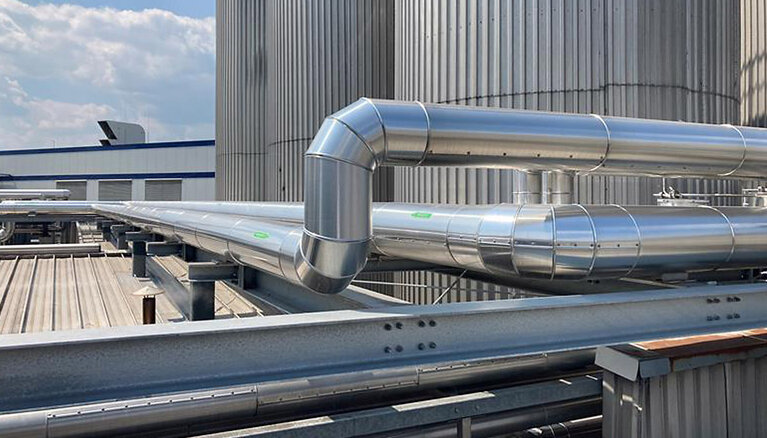
The project is also seen as a beacon from which other companies can benefit and is partly subsidized by the German Federal Ministry of Economics and Climate Protection. Lars Dammann, Head of Occupational Safety and Environment at DMK, explains how it all works.
Dairy processing is an energy-intensive industry: For example, the milk delivered by our farmers has to be heated and then cooled for hygienic reasons. As a heat source, we use superheated steam from our own combined heat and power plant. The plant already has a high energy efficiency, but it has now been significantly optimized by improvements in the use of waste heat. But because we rely on heating and cooling processes in many areas of production, we thought about new ways to save energy and be more sustainable at the same time.

The key points of the changeover are intelligent heat recovery from exhaust air, a buffer tank for more efficient use of waste heat, and the use of hot water wherever possible. For example, thanks to modern heat exchangers (economizers), we are now making much better use of the heat from the flue gas of the combined-cycle power plant and have already been able to increase energy efficiency by 15 percent by recovering heat from the flue gas. The residual heat from the hot exhaust air is stored in a 300,000-liter buffer water tank. From there, it is fed into the heating circuits as needed. To take advantage of different temperature flows, DMK has supplemented the existing steam network with hot water networks of 60 and 45 degrees. This is because many processes in our dairy do not require 100-degree steam at all. For some steps in cheese production, 60-degree water is sufficient.
A network of pipes with water heated to 30 degrees was already in place at the site, and DMK uses this heat cycle to heat the milk for cheese production. In the process, heat is extracted from the water, which then has a temperature of only 10 degrees. This much colder water is in turn used to pre-cool the whey produced during the cheese-making process. These "heat swings" intelligently link heat sources and heat sinks, saving enormous amounts of energy. and save an enormous amount of energy.

We have been operating since March 2023 and are already seeing the positive effects. In addition to natural gas, we are now also saving 200 megawatt hours of electricity per year in Edewecht. And in terms of C02 emissions, our expectations have already been exceeded: instead of the 5,000 tons originally forecast, we expect to save up to 6,000 tons of greenhouse gas. In the first half of 2023, we have already achieved 11.6 GWh of gas savings and 2,600 tons of CO2 reductions. As prices for fossil fuels and CO2 certificates are likely to continue to rise, we see our project as a model for many other manufacturing companies with similar technical equipment. We intend to transfer the efficiency measures from Edewecht to other of our more than 20 sites - a similar project is already underway in the Netherlands, and preparations are underway at our Zeven site. Heat pump technology was not yet an issue for us when we were planning the project; it has only recently taken a leap forward. Therefore, we will definitely integrate it in future DMK projects.

In any case, the changeover during ongoing operations was a particular challenge. A cheese factory cannot simply be shut down and restarted. Things got complicated when it came to laying the pipes for the different hot water streams: For structural reasons, we couldn't lay the pipes on the existing pipe bridge as we had originally thought. So the pipes had to be laid across the entire site. To make matters worse, construction costs and metal prices had risen sharply during the project: a stainless steel tank suddenly cost twice as much. Heat exchangers were also about 40 percent more expensive. I am glad that we were able to complete the project, that everything is running as planned, and that the investment is paying off, even with the increased costs.
